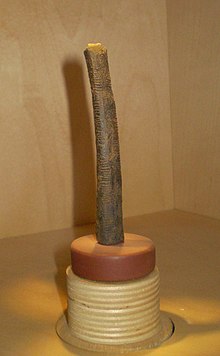伊尚戈骨
伊尚戈骨是一个骨器,可追溯至旧石器时代早期。它是一条暗褐色的狒狒的腓骨,[1]其一端嵌有一块锋利的石英,也许为了用于雕刻。一开始它被认为是一根记数棍,因为上面的三列刻痕被解释为计数符号,但是也有人认为这些刻痕只是为了方便抓握,或者其他的非数学的理由。[2]
伊尚戈骨于1960年由比利时人Jean de Heinzelin de Braucourt发现,当时他正在探索比属刚果区域。[3]发掘之处位于塞姆利基河附近的伊尚戈地区。[4]爱德华湖汇入塞姆利河,形成了尼罗河流域的部分源头(今乌干达和刚果民主共和国的边境上)。骨头发现的地方是非洲这个区域一个小型的渔猎采集社区的遗迹。这个定居点焚毁于一次火山爆发。[5][6]
这个人造物最初被估计起源于公元前9000年到公元前6500多年。[7]然而,在重新评估了发掘地点的年代后,现在它其历史超过20000年(公元前18000年到公元前20000年之间)。[8][9]
数学解释
骨头上的刻痕分成不对称的三列,这导致了“各种诱人的假设”,[13]例如被用来作为一个计算工具、用于简单的数学流程或者用来构造一个数字系统。
第三列被解释为“质数表”,[14] 但这更有可能只是一个巧合。数学史家彼得‧S‧鲁德曼认为,直到约公元前500年人类才理解了质数,而质数的概念直接依赖于整除的概念,这一概念的出现应该不早于公元前10,000年。[15]
亚历山大‧马沙克则推测,伊尚戈骨代表一个六个月为周期的太阴历(基于月相的历法)。克劳迪娅‧扎斯拉夫斯凯就此认为,这个工具创造者可能是一个女人,用来跟踪月相周期相关的月经周期。[16][17]也有人反对这一观点,他们认为马沙克过度解释了数据,证据并不足以支持这是太阴历。[18]
第二块骨头
1959年对伊尚戈地区的早期挖掘中,还发现了另外一块骨头。颜色更淡,被刮削、打薄并打磨过,一端已经破损,暴露出空腔。这个古物可能和著名的那块骨头一样,一端嵌有石英,作为一个工具的把手使用。14厘米的长骨的六个侧面,刻有90个刻痕,根据长度被归类为“主要的”或“轻微的”。Jean de Heinzelin的解释认为主要刻痕为单位或倍数,而轻微的是分数或者余数。他认为这块骨头是用来记录10进制和12进制换算规则的。[19]
参看
参考文献
- ^ A very brief history of pure mathematics: The Ishango Bone. [2018-07-26]. (原始内容存档于2008-07-21).
- ^ Rudman, Peter Strom. How Mathematics Happened: The First 50,000 Years. Prometheus Books. 2007: 63. ISBN 978-1-59102-477-4.
- ^ de Heinzelin, Jean: "Ishango", Scientific American, 206:6 (June 1962) 105--116.
- ^ Lake Edward. [12 October 2014]. (原始内容存档于2016-06-23).
- ^ Williams, Scott W.: "Mathematicians of the African Diaspora (页面存档备份,存于互联网档案馆)" The Mathematics Department of The State University of New York at Buffalo.
- ^ D. Huylebrouck, The Bone that Began the Space Odyssey[永久失效链接], The Mathematical Intelligencer vol 18 no. 4
- ^ Gerdes, Paulus (1991): On The History of Mathematics in Africa South of the Sahara (页面存档备份,存于互联网档案馆); African Mathematical Union, Commission on the History of Mathematics in Africa.
- ^ Marshack, Alexander (1991): The Roots of Civilization, Colonial Hill, Mount Kisco, NY.
- ^ Brooks, A.S. and Smith, C.C. (1987): "Ishango revisited: new age determinations and cultural interpretations", The African Archaeological Review, 5 : 65-78.
- ^ Introduction (页面存档备份,存于互联网档案馆), Royal Belgian Institute of Natural Sciences, Brussels, Belgium.
- ^ Flash presentation (页面存档备份,存于互联网档案馆), Royal Belgian Institute of Natural Sciences, Brussels, Belgium.
- ^ The Ishango Bone, Democratic Republic of the Congo (页面存档备份,存于互联网档案馆), on permanent display at the Royal Belgian Institute of Natural Sciences, Brussels, Belgium.
- ^ Everett, Caleb. Numbers and the Making of Us: Counting and the Course of Human Cultures. Harvard University Press. 2017: 35. ISBN 9780674504431.
- ^ Williams, Scott W.: "Mathematicians of the African Diaspora" The Mathematics Department of The State University of New York at Buffalo.[1] (页面存档备份,存于互联网档案馆)
- ^ Rudman, Peter Strom. How Mathematics Happened: The First 50,000 Years. Prometheus Books. 2007: 64. ISBN 978-1-59102-477-4.
- ^ Zaslavsky, Claudia: Africa Counts: Number and Pattern in African Culture, L. Hill, 1979.
- ^ Zaslavsky, Claudia: "Women as the First Mathematicians (页面存档备份,存于互联网档案馆)", International Study Group on Ethnomathematics Newsletter, Volume 7 Number 1, 1992|January 1992.
- ^ Robinson, Judy. 1992.
- ^ The Second Bone. [12 October 2014]. (原始内容存档于2016-06-23).
延伸阅读
- Shurkin, J.: Engines of the mind: a history of the computer, W. W. Norton & Co., 1984., p21
- Bogoshi, J., Naidoo, K. and Webb, J.: "The oldest mathematical artifact", Math. Gazette, 71:458 (1987) 294.
外部链接
- Ishango, 22000 and 50 years later: the cradle of mathematics?
- Template:OEIS el
- O. Keller, "The fables of Ishango, or the irresistible temptation of mathematical fiction", [2](页面存档备份,存于互联网档案馆)
- V. Pletser, D. Huylebrouck, "Contradictions and narrowness of views in "The fables of Ishango, or the irresistible temptation of mathematical fiction", answers and updates", [3] (页面存档备份,存于互联网档案馆)
